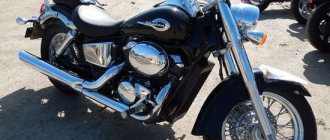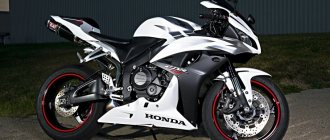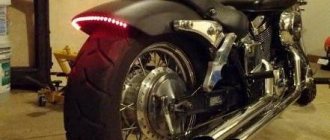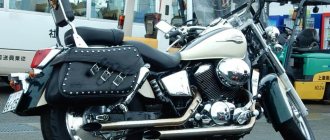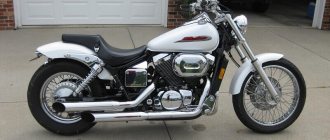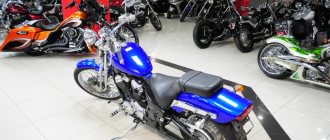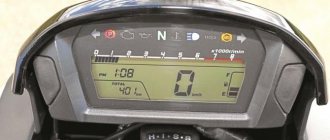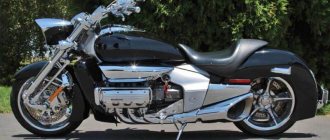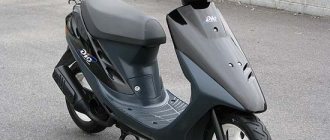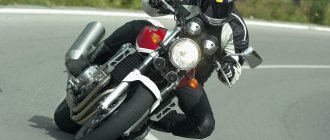Japanese motorcyclesHonda motorcycles
Honda X 11 is the first model of its kind, which is unique in concept: it was originally created as a hybrid of a sports and touring bike, and then improved to a naked one.
Naked (naked) - from English the word “naked” is translated as undressed, naked.
This style is distinguished by the absence of a frame (plastic cladding). Sometimes mistakenly confused with a bobber.
Specifications
The developers paid great attention to the frame, so it is equipped with aerodynamic elements.
The radiator is lined in such a way as to create a “wing” effect, and the instrument readout perfectly performs protective functions (we are talking about protection from wind and rain). In addition to an excellent frame, the bike is equipped with a suspension that performs perfectly in any conditions. Only during high acceleration does the rear swingarm seem rather weak. The transmission and operation of the gearbox are simply a song.
Many Honda models can boast of such qualities, but in the X-11 they achieve the ideal. Also a plus is definitely the combined braking system, which provides excellent maneuverability in the city.
A separate point I would like to note is the excellent engine, which is not suitable only for aggressive driving.
The engine parameters are well-trained, as evidenced by 24 tamed horsepower and refined transmission operation.
Of course, there were some downsides. There is no progression observed in the pendulum - this is the case. This is felt only in certain driving modes.
Second: the timing belt consumables, or more precisely, their tensioner, were let down. Replacing these parts is also difficult. The third disadvantage is that it is impossible to install an inverted fork, taking into account the preservation of CBS.
| Characteristics and performance of the Honda model X 11 | |
| Year of issue | 1999 |
| Volume of the tank | 22 liters |
| Clearance | 14 cm |
| Engine | Injection four-cylinder |
| Transmission | 5 steps |
| Max. power | 136 l. With. (2001 model) |
| Engine cooling | Liquid |
| Fuel supply | Injection |
| Front suspension | Telescopic fork |
| Rear suspension | Pendulum system with shock absorber |
| Front brakes | Disk |
| Rear brakes | Disk |
| Front tires | 120/70-17 |
| Rear tires | 180/55-17 |
| Fuel consumption (average data) | 9 l/100 km |
| Max. speed | 240 km/h |
| Dimensions | Height - 79.5 cm; Length - 214.5 cm; Width – 111.5 cm; Weight – 222 kg |
Honda cb 1300 review
The heart of the first-generation motorcycle flagship was a power plant with four in-line cylinders designated SC38. Its volume was 1284 cubic meters. see, which was enough to pump 100 hp. At the same time, such a parameter as torque reached 120 Nm. As with most older motorcycles, early Honda cb 1300s were equipped with carburetors.
honda 1300
The injection mechanism was modernized in 2003: the cb1300 acquired an injection engine under the symbol SC54E, which contributed to the acceleration of power to 115 “horses”.
Also, among the features of the Honda 1300 motorcycle, the technical characteristics of which can give odds to any modern analogue, we can highlight:
- – multi-stage gearbox (before 2014 – 5 steps, after – 6);
- – 21-liter fuel tank;
- – serious dimensions and curb weight (252-284 kg), which is very useful for pilots with great height and athletic build;
- – a traditional suspension system, which consists of a telescopic fork at the front and dual shock absorbers at the rear;
- – duplex stainless steel frame;
- – anti-lock braking system (abbr. ABS)
Let us immediately note that individual indicators and mechanisms may change or be completely absent due to the evolution of the hero of the topic. For this reason, studying the Honda SB 1300 model range makes a lot of sense.
Chassis and brakes
The space frame of this bike is made of aluminum, which makes it somewhat lighter. The X11's body is elegant, and every detail has been thought through to the utmost. Even the shape of the instrument panel is designed to improve the wind protection of the motorcycle. The wheel rims are, of course, alloy.
The rear suspension is pendulum, equipped with a monoshock absorber. At the front there is a 43 mm telescopic fork. The X11 brakes at the rear using a 256 mm disc together with a three-piston caliper, and at the front for these purposes a pair of 310 mm discs and three-piston calipers are used.
Classification of Honda motorcycle models by purpose
Honda Super sport
1. Super sport / Super sport - this class of Honda motorcycles, created on the basis of racing models, has the same lowered handlebars and rider position, massive fairings, pumped-up engines, etc. – CBR1000RR Fireblade is the best Honda motorcycle model in its class, with a capacity of 999 cc. see, it has a power of 178 horsepower with a torque of 113 Nm. – The CBR600RR has 4 cylinders with a capacity of 599cc. Motorcycle power – 120 hp.
Honda Street Fighter
3. Sports Tourer / Sports Tourer - these Honda motorcycle models are a combination of classic and sports classes. – VFR1200FD has all the advantages of Super sport models (4-cylinder engine with a capacity of 1200 cc), but at the same time has a more comfortable fit; – VFR 800F Honda engineers installed a 4-cylinder engine of 781.7 cc on this model. cm, capable of developing 109 hp. (80 Nm); – 500RA and 300RA both models are distinguished by their simplicity and ease of operation, practicality and efficiency. The models differ from each other only in engines, in the first case it is 48 horses produced by a 2-cylinder engine with a volume of 471 cubic meters. cm., and in the second - 1 cylinder with a power of 30 hp. with a volume of 286 cubes; – CBR250R, single-cylinder motorcycle with a displacement of 249 cubic centimeters and a power of 26 hp. Developed by Honda for the markets of India and Thailand, where the demand for motorcycles of this class is high; – CBR650F, this Honda model will ideally act as the first budget bike, and will also appeal to experienced motorcyclists without “Freaks”. Having an unboosted 4-cylinder water-cooled engine, it is capable of producing 78 hp. (63 Nm).
Honda Touring4. Tourer / Touring - limousines among motorcycles, the only purpose of this Honda model is travel. An engine like a car, a huge gas tank, a comfortable seating position, the presence of a mini refrigerator, a decent stereo system, as well as an airbag, this is not a complete list of differences between the Honda Tourer and a motorcycle. – ST1300 Pan European, this Honda model is not inferior, and in some aspects it surpasses competitors from Europe and America. V4 engine, 1261 cc. cm develops 126 hp; – GL1800 Bagger is a lightweight version of the legendary GL 1800 Gold Wing. An almost 2-liter, six-boiler boxer engine with 117 horsepower is capable of accelerating this Honda to hundreds in 5.5 seconds; – GL1800 Gold Wing is the flagship of the Honda company, one of the most expensive series models in the world.
Honda Cruiser
5. Cruiser – the Honda GL1800 Gold Wing can be classified in this category, although the company itself classifies it as a Touring class. – GL1800 F6C Valkyrie has the same power unit as the Gold and a sportier look.
Honda Dragster
6. Dragster / Dragster - the constituent features of this model are: an extended wheelbase and a forced engine. – CB1300DC (SC38) – also known as X4.
Enduro tourer
7. Enduro / Enduro-tourer – Honda engineers took cross-country models as the basis for bikes of this class, resulting in a motorcycle for active recreation. – XL 600 V Transalp with a 583 cc engine, initially aimed at the European market, the Japanese created a model with a 400 cc engine – Honda XL400V Transalp.
Honda Motard
8. Motard / Supermotard - this class of motorcycles is located between the enduro and motocross models of Honda. He can move around the city and at the same time take part in serious sports competitions.
Honda Cross
9. Cross/Cross – motorcycles of this class are classified as sports equipment; they cannot travel on public roads and are not registered with the traffic police. However, there is a plus: you don’t need a license to drive.
Post Views: 5,021
HONDA NC750X – display
The display deserves special attention. Unfortunately it doesn't show the engine temperature and the RPM seems so belt-hating, but otherwise it's quite functional and changes color. And now, depending on the mode, these colors can communicate what gear we're running, or when to change course, or what mode the box is in, or... and this was the mode that was used most often: economy information. There is also a clear indication of the speed at which we are moving. You can also change the intensity of the backlight and widgets such as the welcome text... unfortunately, this is often barely noticeable because the display is difficult to see when exposed to bright light.
Honda NC750X
Estimated cost
Since Drozd was produced for only a few years , you are unlikely to find a new one.
But among used bikes there are many good options that cost around $400.
The estimated price may vary depending on the condition and mileage of the motorcycle from $300 to $600.
Simple and easy to drive, the Honda CBR 600 RR delivers performance in all conditions, be it the race track or narrow city streets.
This article reviews a motorcycle that is well suited for dense city traffic and maneuvering between cars in traffic jams.
The agony of choice
Initially, of course, I wanted a super sport: a gixeur or razor, with a volume of at least a liter. Despite the burning desire to quickly become the owner of my own rocket, I did not rush to purchase it. If you have money on hand, then you need to consider all the options, and you certainly shouldn’t rush. The jumping dollar exchange rate significantly reduced my financial potential, and I could no longer consider new models whose cost now started at half a million.
I lived most of my life in the Far East and somehow I formed a perhaps biased, but never disappointing opinion - if a used car, then a Toyota, if a used motorcycle, then a Honda. No, I didn’t insist - “Honda and that’s it”, I just left it with an advantage despite all the others. With such presets I began to study the market.
I decided to look at all the models. I watched sports as a priority. I looked and was sad. Almost all motorcycles have been reclaimed not even by the seller, but by the previous owner. One thing was certain about this “pig in a poke” - he would definitely be sick with something.
Having seen enough of the sports, standard models, I lost all interest in them. Somehow suddenly plastic stopped exciting me. Monotonous soap dishes - they are for athletes and those who want to appear like them, but I am not one and apparently not another. Of course, sport is cool, but if something more is possible, then why remain within the framework of prejudices.
Despite the cooling towards sports plastic, I still did not discover a love for the classics and chopper-shaped ones. I wanted something between a sport and a road worker, as they say: “a creature with the loyalty of a cat and the cleanliness of a dog.” In an attempt to find a compromise, I decided that my choice was a naked bike, preferably with streetfighter aspirations.
Looking at the Ducati Monster, I realized that I needed something similar, but more reliable and less difficult to maintain, since we are talking about a used one. I admit, if I were to go for a new one, it would very likely be a Ducati Monster, although….
Although there is a choice when it comes to money, there wasn’t much money. Having sobered up from the charm of the Italian monster, I began to look for something similar from the Japanese
Of course, I couldn't help but pay attention to the X-11, based on the Honda CBR 1100 XX Super Blackbird. The bike seemed strange at first
But there was something in this strangeness, something that did not allow me to close the browser bookmark. A powerful silhouette with sporty features, a round headlight, the exterior does not flirt with you with flirty plastic or blinds you with vanity chrome. A rare beast.
The model is not ordinary, I had to plunge into the study of characteristics, reviews of owners, and expert opinions. The more I learned about the motorcycle, the more I became convinced that this was the one I needed. But the dilemma was that the production of the X was discontinued in the early 2000s, which meant that the moto wouldn’t be young – that’s a minus, but it wasn’t expensive either – that’s a plus. The legendary reliability and durability of the base model became a powerful argument in making the decision.
The model is selected, then the seller with the desired product is selected. I won’t even say anything about what is sold in Russia. No, of course there is something good, but correctly separating the wheat from the chaff is a process whose outcome we cannot predict. In general, I decided to look at the statistics of Japanese auctions, calculate, estimate.
Rummaging through the sales history, I realized that a spendthrift doesn’t often slip through the cracks at auction. Without much hope for a quick result, I entered the lots of the upcoming auction. And so! Tomorrow there are already 2 X's in the auction, one is tired, and the other is completely fine, with a good estimate, European tidy and wine. I immediately call Vladivostok, discuss the nuances of auction marks with a knowledgeable person, and order participation in the auction. The next morning I find out that the motorcycle is mine. Further payments and painful waiting. I even found out which ferry would transport him, it was not difficult, and then, using a special service, I tracked his intricate route.
The motorcycle arrived in St. Petersburg by train. My friend and I went to pick it up. We waited an hour for them to take us out. The hour has never been so long. The whole world is tired of living it. As we unboxed the bike got bigger and bigger. At some point I even doubted whether it was too big. Then they filled it with gas, lit a cigarette and it started. I won’t go into an artistic description of the sound of the engine; everyone already understands that it was something. Next is the road to the garage and taming the beast.
Hello everyone, motorcycle brothers!
Here is my motorcycle story, about 25 years long, and a story about my X11 Rhino... I grew up on 2-wheeled vehicles, all kinds of bicycles, then Carpathians 2, then in the early 90s they began to transport Japanese “stools” from Primorye and such a device appeared in my possession. Then the destroyed Jupiter 5, bought from a parking lot. Then Planet 7 (hydraulic disc front brakes, alloy wheels, air fork) in perfect condition, on which I traveled to all the dachas and the surrounding area for 4 years. I got off the scaffold only to go to bed, spent all day and night on it from April to October, in the rain and in the mud... In the second half of the 90s, information about imported motorcycles began to appear very sparsely. One of the pioneers in their sale was NBS-Motor in Novosibirsk. My father had a very warm and loving attitude towards motorcycles, as he also grew up riding them. 1999, April and now we at NBS-Motor are already choosing a motorcycle)) An SV750 was purchased, which we rode for a season. I mostly drove it. After the CBI, the X4 appeared. I was in love with it with all my heart and skated 4 seasons on it. The device still deserves a lot of attention, but 19 years ago it was simply unreal. Beautiful, powerful, stylish... But, meager fuel supply, non-energy-intensive suspensions, heavy front end. But I also managed to lift it onto the back, although it is not suitable for this. At that time I was young and hot-headed with a “bad” head, I drove an X4 “with all my money”, sometimes I changed the chain and sprockets 2 times a season due to the fact that this unit could not withstand the hellish accelerations and the chain was stretched, the sprockets came into unusable... In 2001, I brought the X4 to NBS for service (more precisely, they removed the speed limiter and installed forward flow) and saw the X11 in the exhibition hall. And I haven’t been able to forget him since then. That example was tuned to the bones in Japan; the owner of NBS-Motor, the late Roman Dobkin, brought it to him (may he rest in peace, he was an interesting man). I haven't had my own motorcycle since 2003. But I rode out 3-5 times a season on my dad’s bikes. He always had several fundamentally different devices in his garage. The X4 was not to his liking; in 2004, he bought an Africa Twin and drove it to various picturesque and difficult-to-reach places. Altai has been searched far and wide. After Africa, he purchased an R1200GS Adventure, which he drove for about 100 thousand kilometers, several trips to Europe under his own power from Russia. After that Goose, I bought a new Goose again. On the “acting” Gus, the odometer is also already under a hundred. Goose is his main and favorite motorcycle. In parallel with the Goose, a new Gold Wing was purchased; my father also used it for very long trips (Europe, England). A few years later, Gold was sold without much regret, as it was idle in the garage. It is not suitable for Russian realities. Although, it definitely has its own zest and strengths (the engine alone is worth it). At the dacha there is always a light enduro XR250 in the garage for fun rides. There is also a Burgman 650 maxi-scooter in the garage for trips around the city, but in recent years it has also been collecting dust in the garage with sad eyes. I sometimes rode all the bikes listed, 3-5 outings per season. Sometimes intercity travel is 300-600 km one way to various biker rallies. But I still didn’t have my iron friend. About 3-4 years ago, in the spring, I began to experience exacerbations and, foaming at the mouth, I began to study what was being sold on the secondary market. I was looking at X11. But it was not possible to buy anything, everything was limited at the level of “wants”. Either you have to pay for utilities, then you have to buy new tires for your car, or your sneakers will tear... I wanted a Japanese scented version, preferably with a plow and direct flow. And then in May 2022, I came across an excellent option: blue (as I wanted), mileage 31 thousand, excellent condition, reasonable price, located 280 kilometers from me. The next day I’m already driving there with a snowmobile trailer, clutching the required amount in a sweaty fist. The deal was done, the sword came true!!! During this season I drove 6500 km, without intercity travel. Every single day to work, to work, from work, to the grocery store, and so on. Long motorcycle trips are not my coat! Despite the fact that I had experience of relatively long trips on motorcycles, which are considered the crown of the long-distance motorcycle industry. The Goose is, of course, a very cool bike in all respects (except for the ridiculous price), but it does not suit my needs (and financial capabilities). I respect this model, but I don’t want one like this at all. Why X11? 1. Because I use a bike for everyday use as my main vehicle in the warm season, thereby combining business with pleasure. Over the summer I drove a car for at most 5 days, the rest of the time on a bike. 2. Because I love powerful motorcycles, sometimes I like to ride on the back. X11 allows you to do this even from 2nd gear. Some craftsmen lift with the 3rd, but I haven’t tried it. On the second one, I accelerated in reverse to 160 km/h, I decided not to do that again)))) A week after the purchase, I already felt at one with the motorcycle. I understood it, I felt it. It’s like I’ve been driving it for 5 years already. In city traffic, the X11 is simply a fairy tale! This is exactly what I wanted. Feels great between rows, locomotive traction in almost any engine speed range. Comfortable suspension, excellent handling, excellent braking system, extremely reliable components and assemblies and much more. I live in a satellite city, which is located 9 kilometers of a divided highway from the city. Thus, on any day it is possible to reach speeds of over 200 while “flying” home from work)) The highway allows you to go 300 easily there (a bike does not allow it). I accelerated my rhino to 262 according to the navigator: I have different drive/drive sprockets and a larger rear wheel. My bike was made for the Japanese market, but has been fully customized, including a European dashboard. Over the course of the season, the motorcycle was partially modified to suit my taste and color: 1. The brake light was replaced with an LED “two circles” one. 2. The turn signal repeaters have been replaced with LED “running” ones. 3. The interior of the headlight has been replaced with an LED lensed one, while maintaining the classic round headlight body. 4. The brake and clutch levers have been replaced with folding ones, adjustable in length and stroke of the lever. 5. The mirrors were replaced with narrower ones to reduce the width of the bike. 6. The stars and chain are changed, with a change in gear ratios. 7. Installed an “enlarged” rear wheel 190/55 8. New front brake “petal” discs. 9. The grips and sliders of the steering wheel have been replaced with “tuned” ones. 10. Two Brothers Racing Black series exhaust system installed. 11. LED running lights are installed on the fork legs. 12. A bag is installed on the passenger seat. 13. The fork was rebuilt with replacement of seals, O-rings and fluid. 14. In Belarus, one craftsman (found through a specialized forum) ordered the production of a rear fender liner ala “for a sportbike”, with the transfer of the seat lock cylinder and without the rear wing.
For this purpose, a bracket for mounting the license plate and rear turn signals was ordered. 15. Ordered an original timing chain tensioner. When buying a bike with a cold engine, noises were present, the tensioner was “tightened” according to the diagram outlined on the specialized forum. The noise has gone away, but having a new tensioner in stock won't hurt. That's all for now. I don’t like to ride with a passenger, because the behavior of the motorcycle changes. Just like on a snowmobile, I think that this technique is for one driver. Without any passengers. Although, of course, I went to the suburbs on a bike several times for barbecue with my wife. Considering that I am no longer a teenager, that I have considerable experience in operating different motorcycles, that in 18 years I have not changed my mind about the motorcycle model I need, I am sure that X will be in my garage for a long time. I sincerely don’t see a replacement for it based on my preferences for a motorcycle. You can drive at a speed of 220 or more on the X11, with special fanaticism, for about five minutes, no more))) Although on the X4 after 160 it was already starting to take your head off. And this also suits me in X, because sometimes I don’t need to “fry” 250 for 10 seconds. Get a spoonful of adrenaline and good. I went on an intercity trip with my wife for 200 km back and forth, walking 140-150. The neck is noticeably tired. But I’m not interested in intercity trips.
HONDA VFR800X – engine
walks around the city
Honda VFR800X Crossrunner
This solution also worked in a motorcycle. Of course, you can feel it when a sharper shaft enters. The difference is noticeable, you feel a jerk, the motorcycle begins to tear when you lose the muzzle. At the same time, this can be heard on the standard exhaust. The pleasant noise turns into a roar (which can be heard a little here). But the transition is not so abrupt as to throw the driver out of the saddle. Of course, you have to be careful because at lower speeds, on slippery asphalt, you can now wobble. To do this, the engine has so much power that the motorcycle brakes the wheel. If VTEC is turned on during such a flight... it may vary
Overall, the engine performs well and has enough power to move those 242 kilograms with pleasant acceleration. However, there are three things to remember. First of all: at lower speeds, up to 3000 rpm, it can “stutter”. In a gear that is too high, the bike will jerk. Second: engine braking at low speeds is practically absent. If we use gas in the VTEC range, we noticeably lose speed. However, at low speeds there is no strong effect, and you need to brake. And thirdly: the engine has an appetite for fuel.
Honda VFR800X Crossrunner
Driving impressions
The motorcycle is massive, it behaves confidently on the road, it doesn’t get blown away by the wind, it feels like a flying machine. There is a feeling of thoughtful wind protection. Relatively soft clutch, on a cable.
The motorcycle has reliable combined brakes, borrowed from the Honda Drozd.
They are designed in such a way that when you press any brake lever, the motorcycle brakes both wheels simultaneously. This motorcycle has clip-ons instead of a standard handlebar, which makes the riding position closer to that of a sports motorcycle. For aggressive and dynamic acceleration, this improvement is only a plus.
Brief history of the model
- 1987 – start of production and sales of the Honda AX-1 model on the Japanese market. Generation I. Frame number – MD21-100XXXX
. Color: dark blue, protective corrugation of the fork legs – dark yellow. - 1988 – start of production and sales of the export version of the Honda NX250 (Dominator). Generation I. Frame number – MD215XXXX
,
MD216XXXXXX
– Europe,
JH2MD21XXXXXXXXXX
– Canada, USA.
Color: white, with dark saddle. The AX-1 model is of the 2nd generation. Frame number – MD21-101XXXX
. Color: white, saddle and fork protection orange. - 1989 – Honda AX-1 is in its third generation. Frame number: – MD21-110XXXX
.
Color: dark blue, dark green saddle, light yellow fork guard. The Honda NX250 (Dominator) model has generation II. Frame number – MD215XXXX
,
MD216XXXXXX
– Europe,
JH2MD21XXXXXXXXXX
– Canada, USA. Dark-blue colour. - 1990 – Honda AX-1 is in its fourth generation. Frame number: – MD21-115XXXX
.
Color: white, saddle and fork protector blue. The Honda NX250 (Dominator) model is produced in the third generation. Frame number: MD215XXXX
,
MD216XXXXXX
,
MD25XXXXX
(Europe),
JH2MD21XXXXXXXXX
(USA). Color: light blue. - 1991 – Honda AX-1 has the V generation. Frame number: – MD21-115XXXX
.
Color: dark blue, light green saddle, AX-1 lettering and turquoise fork guard. The Honda NX250 Dominator is available only for Switzerland. Frame number: – MD255XXXX
. Color: red; saddle, stickers and protective corrugation are blue. - 1993 - The Honda NX250 Dominator model is in its fourth generation and is again available on the European market. Frame number: – MD215XXXXXX
,
MD253XXXXXX
,
MD255XXXXXX
,
JH2MD259*XXXXXXXXXX
. Color: black-red. Last year of production of the model. - 1994 is the last year of production of the Honda AX-1 (Japan). Generation VI. Frame number: MD21-120XXXX
. Color: dark blue, purple saddle.
HONDA VFR800X – suspension
Another plus is the suspension of this motorcycle. We have stepless preload adjustment and 10 degrees of front cupid relief, as well as rebound damping adjustment and 35-degree preload adjustment. I rode on an intermediate setup and the bike handled the potholes nicely, both at leisure speed and during fast acceleration. It floated smoothly over our wavy asphalt, full of spots, holes, depressions and bulges. This is clearly visible in the video review when I am driving along a heavily damaged road. Despite the prevailing potholes, my voice does not tremble, which means that the motorcycle handled these bumps carefully. It is known that when driving faster in the pits, not everything is so colorful, and sometimes the voice gains control over traction. This happened at a time when the moto was losing adhesive contact with the ground as a result of the wheel breaking down on a series of patches. This caused a temporary power outage and slowdown of the Honda VFR800X. But it was enough to cut traction on the highway, and that was after the problem.
Honda VFR800X Crossrunner
Photo gallery
Honda X 11 is power embodied in metal and plastic. Boasting a muscular engine that's shamelessly displayed for all to see, it's not just another high-powered motorcycle for speeding through the streets at night - it's a legend. However, you can evaluate its external data for yourself by carefully examining our selection.
All the way
The motorcycle is equipped with an in-line 2-cylinder medium-sized engine, ideal for a purely urban vehicle. As has been said more than once, the cylinder block of the NC700S power plant is tilted forward, which lowers the center of gravity and loads the front wheel of the naked bike. The Japanese “two” has very moderate vibrations, which I would even call pulsations, and an unusual tuning that gives this weak and “bland” engine even some character.
Although the maximum power of the NC700S engine is, to put it mildly, not impressive (only about 46 hp at the rear wheel), the nature of its output in the Japanese “two” is the most “correct”: absolutely linear, smooth and predictable. But the most interesting thing is on the torque graph, where the thrust curve soars upward like an impregnable cliff already at 2400 rpm and beyond, fluctuating only slightly in value, with a smooth plateau “lasting” until the hard cutoff at 6325 rpm.
Due to this nature of the torque, the NC700S dynamically accelerates almost from idle, and is also extremely tolerant of “pull” driving, errors in gear selection and other typical awkwardnesses of a city dweller tired of moving through traffic jams. An interesting feature of the NC700S is the unobvious moment when the rev limiter is triggered: after several days of testing and several hundred kilometers driven behind the wheel of a Japanese naked bike, I still haven’t learned to determine at what point it’s time to upshift when accelerating!
Neither did any of my colleagues succeed, who, after a test ride, returned the motorcycle in bewilderment with the diagnosis “It doesn’t run, it’s monstrously “choked”... Tests of the NC700S on a dynamometer showed that it does run, and even very well for a 46-horsepower engine. ! And the reason why it is almost impossible to feel the moment at which the tape tachometer scale hits the insurmountable wall of the limiter, which quite harshly cuts off the engine power, is in the torque characteristic of the motor.
Usually, after reaching the maximum thrust value of the power plant, the torque decreases quite quickly, and the motorcycle pilot feels this change in engine operation well. But this does not happen in the case of the in-line “two” naked Honda! Take a look at the torque graph: here at 4785 rpm the maximum thrust value, but at 6325 rpm the limiter is triggered - and the difference in torque is small. In other words, the inexhaustible flow of thrust abruptly bumps into the electronic “noose”, and therefore this moment is unexpected every time.
Brief history of the model
Model:
Honda CB1100 + ABS (Japan, Oceania).
Frame number:
SC65-100XXXX.
Model code
: CB1100A + CB1100AA.
Model:
Honda CB1100 + ABS (Japan, Oceania).
Frame number:
SC65-100XXXX.
Model code
: CB1100B + CB1100AB.
Model:
Honda CB1100 + ABS (Japan, Oceania).
Frame number:
SC65-120XXXX.
Model code
: CB1100C + CB1100AC.
Model:
Honda CB1100 + ABS (Japan, Oceania, Europe, North America).
Frame number:
SC65-120XXXX (Japan);
JH2SC655DK000001, JH2SC651DK000001 (North America). Model code
: CB1100D + CB1100AD.
Model:
Honda CB1100 + ABS + Deluxe;
CB1100EX + ABS (Japan, Oceania, Europe, North America). Frame number:
SC65-130XXXX (Japan);
JH2SC658EK000001, Frame JH2SC651EK100001 (North America). Model code
: CB1100E + CB1100AE; CB1100SE + CB1100SAE.
Model:
Honda CB1100 (ABS) + Deluxe;
CB1100EX (ABS) (Japan, Oceania, Europe, North America). Model code
: CB1100AF; CB1100SAF.
Model:
Honda CB1100 (ABS) + Deluxe;
CB1100EX (ABS) (Japan, Oceania, Europe, North America). Model code
: CB1100AG; CB1100SAG.
Model:
Honda CB1100 (ABS), CB1100EX (ABS);
CB1100RS (Japan, Oceania, Europe, North America). Model code
: CB1100TAH; CB1100CAH; CB1100NAH.
Model:
Honda CB1100 (ABS), CB1100EX (ABS);
CB1100RS (Japan, Oceania, Europe, North America). Model code
: CB1100TAJ; CB1100CAJ; CB1100NAJ.
Model:
Honda CB1100EX (ABS);
CB1100RS (Japan, Oceania, Europe, North America). Model code
: CB1100CAK; CB1100NAK.
Model:
Honda CB1100EX (ABS);
CB1100RS (Japan, Europe). Model code
: CB1100CAL; CB1100NAL.
Bike generations
Today you can find three main generations of this modification of the bike:
- 5th generation - produced from 1998 to 2001. This model used a high-power injection engine, plastic linings from the VTR100 and a combined brake system;
- 6th generation – 2002-2013 The modification is equipped with double exhaust pipes, ABS and a system that changes the timing and stroke of the valves;
- 8th generation – production started in 2014 and continues to this day. Honda vfr 800 Interceptor of this series has an original design, instrument panel, one exhaust, wheels of reduced weight and control of engine power characteristics. In the United States, “Standard” and “DeLuxe” versions are sold; in Europe and the Russian Federation, only “Standard” can be purchased.
Honda vfr 800 vtec is a fairly prestigious type of motorcycle belonging to the “above average” class. But at the same time, the bike is not involved in official motorcycle competitions, since it does not have a sufficient number of additional settings. Among the distinctive features of motorcycles in this series are the aerodynamic front part of the bike, the use of carbon fiber to create body kits, each of which serves as protection for a specific component or assembly. The technical characteristics of the Honda vfr 800 vtec model are such that the tail can be dismantled without any problems to access a specific unit.
First in class sports tourer
Motorsport as a phenomenon dates back to the 30s of the last century.
However, tricks to create a sport-touring bike began only in 1998, when the X11 model was released.
The bike became one of the best in its environment, but never became popular.
The reason for this lies in the average parameters of the motorcycle: the bike’s engine is weaker than on any stormmoto, and the heavy frame and seat are not as comfortable as a grand tourer.
Whatever you say, the model turned out to be an acquired taste, so not everyone can get used to such a unit .
Honda X 11 became the favorite of the developers, which was worked out very thoroughly.
As a result, all irregularities and incomprehensible clutter turn out to be carefully thought out and simply necessary for a comfortable ride.
Sports motorcycles
Sports-class motorcycles are designed for maximum speed performance when riding on a highway with high-quality hard surface. To reduce aerodynamic drag at high speeds, sportbikes have streamlined shapes. Sports models have a memorable exterior: characterized by a low steering wheel position, high footrests, a highly accelerated, sharp engine and a high-performance braking system. The position of the body is such that the legs are located as close to the body as possible. Most models are equipped with a six-speed transmission. High maneuverability allows the sportbike to be used in urban environments. Wide wheels provide this motorcycle with excellent traction. Experience and good driving skills are prerequisites for driving a sports bike. A typical representative of sport bikes is the Honda CBR 600 RR. Some models of sport bikes have a universal purpose, for example, sports tourism, enduro touring. Others are intended exclusively for motorcycle racing.
Japanese manufacturers Suzuki, Honda, Kawasaki and Yamaha are the undoubted favorites in the production of sport bikes. The 1997 Kawasaki Ninja 600 ZX-6R motorcycle is still popular. Yamaha has launched a worthy competitor to Suzuki - the YZF-R125 model with an engine capacity of 125 cm? and the Yamaha YZF-R1, a child of Moto GP technology.
Among European manufacturers, the traditional leaders are the German BMW and the Italian Ducati.
These companies strive year after year to displace Japanese competitors from the top of the racing Olympus. Sometimes they succeed, and sportbikes from European manufacturers make it to the list of the best. Models like the BMW HP2 Sport are consistently popular
The main advantages are German reliability, excellent assembly and attention to detail. At the same time, the cost of BMW sportbikes is acceptable for the average European
In the “sport” class, the Bavarians are now leading the following models: • HP4 model 2013, 1,000 cm?, 193 hp. s at 13,000 rpm. 112 nm at 9,700 rpm. And, best of all, 200 km/h. • K 1 300 S – 1 293 cm? , 175 l. s at 9,250 rpm, 140 nm at 8,250 rpm. • S RR 1,000. Engine capacity 999 cm³, power – 193 hp. s at 13,000 rpm. Italian sportbikes from Ducati also often reach the podium. Among them, it should be noted: • Ducati Superbike 1199 Panigale R. In the 1,200 cc class, a worthy competitor for any Japanese equipment in this segment. Serially produced since 2012. Power 195 l. s at 10,750 rpm, torque – 132 Nm at 9000 rpm. • Ducati Superbike 848 EVO Corse SE – 2011 model, 849 cc/140 hp. With.
